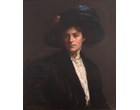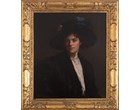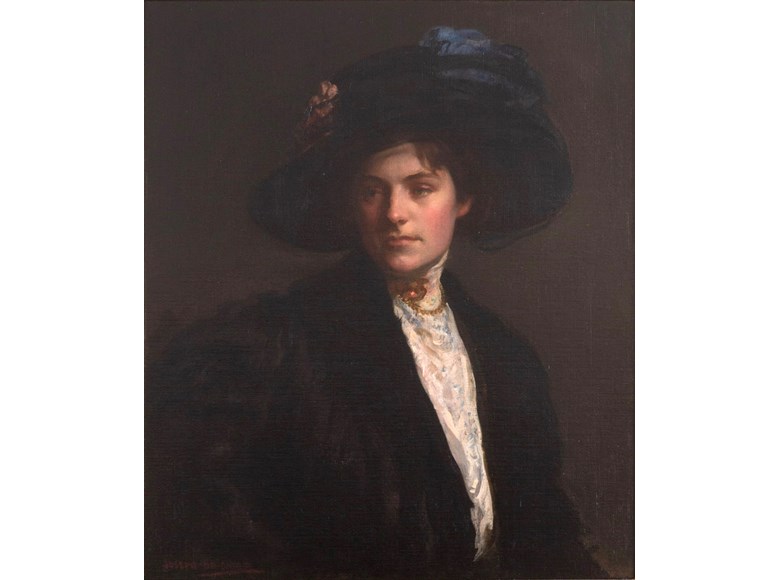 BACK TO GALLERY
BACK TO GALLERY
Avery Galleries
Joseph DeCamp
The Fur Jacket
Signed lower left: JOSEPH DE-CAMP
30 1/8 x 25 inches (76.5 x 63.5 cm)
description
Born in Cincinnati, Ohio, Joseph Rodefer DeCamp studied briefly at the McMicken School of Design before traveling abroad and enrolling at the Royal Academy in Munich in 1878. He quickly became part of the close-knit circle of American students working under Frank Duveneck in the Bavarian village of Polling and traveled with Duveneck to Venice and Florence to study old master paintings. DeCamp returned to the Ohio area in 1883 and took teaching positions at art academies in Cleveland, but by 1884, he had settled in Boston where he became an influential teacher, beginning at Wellesley College from 1884 to 1886. He also taught at the School of Drawing and Painting at the Museum of Fine Arts from 1885 to 1889, the Cowles School of Art beginning around 1890 and the Massachusetts Normal Art School from 1903 to 1923.
In 1897, DeCamp became one of the founding members of the Impressionist group, the Ten American Painters, along with Boston friends Frank W. Benson and Edmund C. Tarbell. His career was on the ascendancy through widespread exhibitions of his figural work and landscapes when disaster struck in 1904 and his studio in the Harcourt Building burned down. Starting from scratch, he offered to paint fellow St. Botolph Club members at a reduced rate, thus establishing himself as one of Boston’s foremost portrait artists. For the next fifteen years, DeCamp went on to capture the likenesses of many notable sitters, including Benjamin Ames Kimball (1905), Charles Henry Taylor (1913), his teacher Frank Duveneck (1911-12) and President Theodore Roosevelt (1908).
While his strength as a portrait artist is well-documented, DeCamp is equally celebrated for his exquisite paintings of elegant young women in classic interiors, key elements of the Boston School style that was embraced by friends and fellow artists Tarbell, Benson, William McGregor Paxton, and Philip Leslie Hale. DeCamp was especially masterful in his rendering of form and light when it concerned the flesh tones of his models and the surface textures of their attire. Painted in 1910 and descending in the DeCamp family to present, The Fur Jacket exemplifies this quality of his work through his successful handling of the namesake garment emerging from the similarly dark colored background, while the blue and pink flowers adorning the matching hat have been cleverly echoed in the lace of the sitter’s blouse and in the lights and shadows of her face. In her 1995 monograph on the artist, Laurene Buckley identifies the model as Agnes Woodbury, who appeared in several DeCamp figure paintings from this period, including The Guitar Player (1908), which is now in the collection of the Museum of Fine Arts, Boston. The Fur Jacket was exhibited at several venues in 1910, including the Pennsylvania Academy of the Fine Arts and the Art Institute of Chicago, and in early 1911 was part of DeCamp’s solo show at the St. Botolph Club.
References: Laurene Buckley, Joseph DeCamp (NY: Prestel, 1996): 55, 148; see also Erica Hirshler’s biography of DeCamp in Trevor Fairbrother, The Bostonians: Painters of an Elegant Age, 1870-1930 (Boston: MFA, 1986).
In 1897, DeCamp became one of the founding members of the Impressionist group, the Ten American Painters, along with Boston friends Frank W. Benson and Edmund C. Tarbell. His career was on the ascendancy through widespread exhibitions of his figural work and landscapes when disaster struck in 1904 and his studio in the Harcourt Building burned down. Starting from scratch, he offered to paint fellow St. Botolph Club members at a reduced rate, thus establishing himself as one of Boston’s foremost portrait artists. For the next fifteen years, DeCamp went on to capture the likenesses of many notable sitters, including Benjamin Ames Kimball (1905), Charles Henry Taylor (1913), his teacher Frank Duveneck (1911-12) and President Theodore Roosevelt (1908).
While his strength as a portrait artist is well-documented, DeCamp is equally celebrated for his exquisite paintings of elegant young women in classic interiors, key elements of the Boston School style that was embraced by friends and fellow artists Tarbell, Benson, William McGregor Paxton, and Philip Leslie Hale. DeCamp was especially masterful in his rendering of form and light when it concerned the flesh tones of his models and the surface textures of their attire. Painted in 1910 and descending in the DeCamp family to present, The Fur Jacket exemplifies this quality of his work through his successful handling of the namesake garment emerging from the similarly dark colored background, while the blue and pink flowers adorning the matching hat have been cleverly echoed in the lace of the sitter’s blouse and in the lights and shadows of her face. In her 1995 monograph on the artist, Laurene Buckley identifies the model as Agnes Woodbury, who appeared in several DeCamp figure paintings from this period, including The Guitar Player (1908), which is now in the collection of the Museum of Fine Arts, Boston. The Fur Jacket was exhibited at several venues in 1910, including the Pennsylvania Academy of the Fine Arts and the Art Institute of Chicago, and in early 1911 was part of DeCamp’s solo show at the St. Botolph Club.
References: Laurene Buckley, Joseph DeCamp (NY: Prestel, 1996): 55, 148; see also Erica Hirshler’s biography of DeCamp in Trevor Fairbrother, The Bostonians: Painters of an Elegant Age, 1870-1930 (Boston: MFA, 1986).








 SEND AN EMAIL
SEND AN EMAIL
 (610) 896-0680
(610) 896-0680